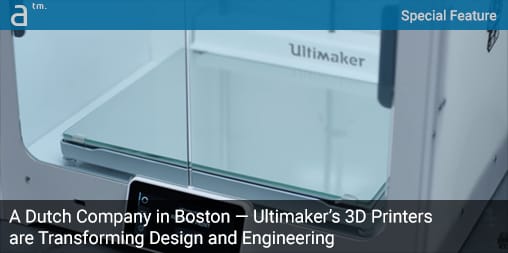RECENTLY I HAD A CHANCE TO talk with John Kawola, President of Ultimaker North America, about his Dutch-based 3D printer company and its presence in the larger 3D market. Our hour-long conversation touched on multiple fascinating points, including the decision for Ultimaker to base their US-based office in Boston, how the 3D printer company got its start, and how Ultimaker sees the overall 3D printing market and their position in it.
A Bit of History—Three Phases of the 3D Printing Industry
While 3D printing may seem relatively new to some within the CAD software industry—and to be honest most companies owning CAD software do not own 3D printers—the industry itself has been around for 30 years, and Kawola been involved in it for decades.
“I was a part of Z Corporation,” says Kawola, “and we sold the company to 3D Systems about six years ago.”
In looking back John Kawola sees the industry in three major phases, which he labels 3D printing 1.0, 3D printing 2.0 and now in the current 3.0 phase. In the 1.0 phase, there were just a couple of major companies back in the ’90s who invented the technologies, protected them with patents and sold their novel printers for more than 200 thousand dollars. As technologies advanced these large and expensive machines fell to prices like 50 thousand dollars, thereby enabling some very larger firms to acquire them as well as big reprographics houses serving thousands of smaller companies.
But somewhere around 2011 or 2012 3D printing entered its 3.0 phase and this is where things began to get really exciting.
“3D printing 2.0 happened around 2000, around nearly 20 years ago,” says Kawola. “I was actually part of 2.0.” What characterized this phase was that big price drop. But somewhere around 2011 or 2012 3D printing entered its 3.0 phase and this is where things began to get really exciting.” So what changed?
He says that the initial 3D printing patents ran out, opening up many smaller rivals to enter the market. The other advance had been made in the metals printing and, of course, the third wave has brought about the sub-three thousand dollar printer. But that’s not where the 3D printing 3.0 era ends. We now have the legendary computer and printer company HP enter the market. And then GE wants in on the game—all signaling just how important the 3D printing industry is turning out to be.
A Dutch Company in Boston
While Kawola has been involved in the 3D printing industry for decades, he landed his new role as President of Ultimaker in North America just a few years ago. The Dutch-based upstart in 3D printing was looking to expand to North America and contacted Kawola about leading their initiatives in the Americas. But the company was thinking New York City.
Kawola convinced Ultimaker’s leadership to settle in Boston instead. “Boston is a pretty good place for this,” adds Kawola, “because, one, there are other 3D printing companies here, but probably more importantly, the CAD companies are here. They are all here; they are all five or ten minutes from where we are.”

01 – A view of the Ultimaker 2+ 3D printer. The feature entry-level device sells for $2,499.USD, making a top-quality 3D printer truly affordable for the average designer or engineer. (image: Ultimaker / Architosh. All rights reserved)
Indeed, Ultimaker’s offices in Cambridge, Massachusetts, are not far from the offices of Onshape. I asked him what it meant to be in the center of it all. Isn’t Boston to the CAD industry what Florence was to the Renaissance? This is where all the leading characters are—this is where the talent and innovation is. “In some ways, we are a little bit of an outsider,” Kawola adds, “because we are a Dutch company who has an office here, whereas the other companies like FormLabs, for example, are native here.”
“SolidWorks was born here, PTC was born here, so we are in the thick of it. So being here means there are meetings, forums, and things to participate in,” he adds. “There is a pro and con for talent. The talent is here but we are all fighting for it.”
next page: The Plummeting Price Drops of 3D Printing




Reader Comments
Comments for this story are closed